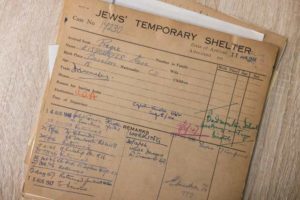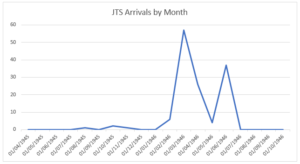Jews’ Temporary Shelter Cards: Charting Patterns of Migration
It’s been a few weeks since we started examining the Jews’ Temporary Shelter (JTS) record cards – so what have we found? Where were large numbers of Jewish Migrants transferring from? And where were they transferring to?
As we examined in the previous blog, Jews’ Temporary Shelter Cards: A Snapshot, the Jewish Temporary Shelter record cards represent a part of the bureaucracy of the JTS. These cards recorded basic details such as an individual or family group name, birth-place, age, trade and means, but also when an individual or family arrived, their reason for leaving home, destination and date of departure. Not all of these cards were created equally, and there was no standardised way of filling the cards in – many have blank boxes, misspellings, ambiguous lines and markings, some represent individual families, others represent whole families. The vast majority of records also fail to note a ‘reasons for leaving home’, meaning that there has to be a large degree of interpretation and analysis of these records.

There are approximately 300 JTS cards in the collection, each dated between 1940 and 1951. Whilst this does not initially present us with an overwhelming amount of data, the dates of these cards help to tell a story of one of the most tumultuous periods of Jewish and migration history throughout the world. Of course, Jewish migration was in no respect a ‘new’ occurrence, and throughout history, even long before the foundations of the Temporary Shelter in 1885 Jews’ have been moved and settled across the world, often for a host of different reasons and more often than not, persecution. The Jewish Museum offers a detailed insight into this in the ‘History: A British Story’ gallery.
What is immediately noticeable in the data was the large numbers of Jews’ coming to London from Czechoslovakia in 1946 – representing the single largest migration of people in the JTS cards collection. Czechoslovakia had experienced some of the most brutal of Hitler’s ideology in the Second World War. Hitler’s ultimate goal was to remove all Czech culture from the area, ultimately designating its citizens as ‘Untermensch’, or inferior peoples.
When Czechoslovakia was formed again after the Second World War, Czechoslovakian leaders insisted on a policy of treating the Germans as the Nazis Treated the Jews’, and whilst this was meant to be ‘carried out in as orderly and humane a manner as possible’, it was often typified by violence. Nationality and language were complex and intertwined histories of Czechoslovakia, but in essence, German speaking peoples in Czechoslovakia were deported from the region. This included German speaking Jews. Not only was the large surge of people a result of the violence and persecution in of the regime in Czechoslovakia, it was also a result of American and British military authorities who ‘had refused to accept individuals and allowed only group transports’, hence the large numbers in 1946.[1]
As we already know from the last blog, most of the people transferring through the JTS were young – between the ages of 15 and 20 – and most travelled alone.[2] Many individuals arrived ‘stateless’, that is to say, that the states for which they previously belonged had stopped recognising them as citizens.

1950 also saw a boost in the number of migrants heading through London, to Liverpool, where they would join the SS Empress of Canada (originally called the Duchess of Richmond) to continue their voyage to Quebec and Montreal. The ship would eventually sink in 1953.[3] Canada had imposed extremely tough immigration restrictions in the pre-war period, but in the late 1940s offered a series of what historians have called ‘token measures’ which encouraged some migrants to make the trip, opening up citizenship to refugees with shared bloodlines with Canadian citizens. This was not to suggest that Canada was completely accepting of Jewish communities – there was still widespreaddiscrimination on the streets and even at the political level, something which would begin to subside in the 1950s [4]

This has been a very broad analysis of some of the data revealed by the cards – and these only represent some of the biggest migrations. There are hundreds of other individual stories to uncover in the collection. In the coming month, you will be able to view these patterns of migration yourself with the JTS cards digital map.
By Lewis Smith, Freelancer for the Jewish Museum London and Researcher at the University of Essex.
The JTS Cards Project, Mapping Migration, is supported by The Audience Agency’s Digitally Democratising Archives project thanks to funding from DCMS and the National Lottery, as part of The National Lottery Heritage Fund’s, Digital Skills for Heritage initiative.
![]()


[1] Čapková, Kateřina. “Between Expulsion and Rescue: The Transports for German-speaking Jews of Czechoslovakia in 1946.” Holocaust and Genocide Studies 32.1 (2018): 66-92.
[2] Gigliotti, Simone, and Monica Tempian, eds. The Young Victims of the Nazi Regime: Migration, the Holocaust and Postwar Displacement. Bloomsbury Publishing, 2016.
[3] “The Canadian Pacific Liner EMPRESS OF CANADA Was Destroyed By Fire In The Gladstone Dock At Liverpool On 25Th January 1953”. Liverpoolships.Org, 2022, http://www.liverpoolships.org/empress_of_canada_loss_by_fire_in_1953.html. Accessed 22 Feb 2022.
[4] Burgard, Antoine. “‘The fight on educating the public to equal treatment for all will have to come later’: Jewish Refugee Activism and Anti-Immigration Sentiment in Immediate Post-War Canada.” London Journal of Canadian Studies 34.6 (2019): 103-122.